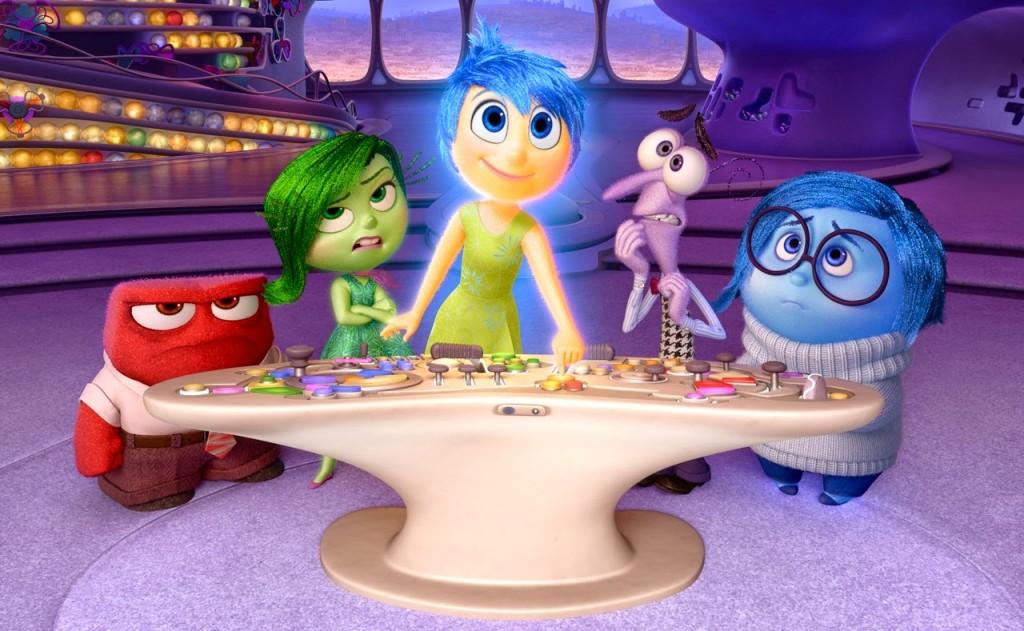A newborn baby girl opens her eyes and finds herself staring up at her parents’ smiling faces. She smiles back at them, unaware that in the recesses of her newly-formed mind, a glowing figure with amber skin caused the expression of happiness with just the push of a button. So begins “Inside Out,” a visually stunning experience that paints a vivid picture of the human mind while simultaneously delivering a concentrated dose of splendor and excitement that is powerfully moving and entertaining.
Produced by Pixar Animation Studios and directed by Pete Docter, who is best known for directing the Academy Award–nominated dramedy “Up,” the film takes place within the conscious mind of Riley Anderson (Kaitlyn Dias), an 11-year-old girl who is guided through everyday life by five personified emotions: Joy (Amy Poehler), Fear (Bill Hader), Disgust (Mindy Kaling), Anger (Lewis Black) and Sadness (Phyllis Smith). When Riley’s family relocates from their Minnesota hometown to San Francisco, her emotions start to butt heads about how Riley should adjust to her new life. Little do they know, they are about to embark on a journey that threatens to affect their relationships with one another — and Riley’s entire outlook on life — in ways they never imagined.
In telling this tale of the struggle to navigate a new environment and the loss of childhood innocence, Docter creates an atmosphere in which every scene is filled with enough beauty and grandeur to keep viewers immersed from beginning to end. The storyline is well-crafted and rendered with purpose, proving that a simple story can offer just as many thrills as the labyrinthine plotlines of films such as “Pitch Perfect 2” and “Saw.”
Poehler and Smith are undoubtedly the film’s most compelling elements, primarily because their characters are in every scene. Poehler successfully manages to embellish Joy’s persistence in the face of adversity by constantly trying to find the fun in every situation, while Smith creates a believable character that viewers, young and old, can identify with. Poehler and Smith also succeed in keeping the plot going in several key instances. One example takes place near the midpoint of the film, when Joy impulsively disagrees with one of Sadness’ ideas, only to later find herself forced to choose between relinquishing her pride or watching Riley’s personality disappear completely. Though estranged at the beginning of the film, both characters tentatively reconcile as they work together to restore Riley’s core memories and get her life back on track.
Hader, Kaling and Black do not disappoint, each giving a performance that emulates their respective character’s primary emotion. Riley’s former imaginary friend Bing Bong (Richard Kind) also does not fail to satisfy, bringing to life a cat/elephant/dolphin hybrid who only wants to see Riley one last time before she forgets him completely. However, by the time the film ends, Poehler and Smith stand above the rest due to the evolution of their relationship from adversaries to allies.
The film constantly draws laughs from the children and adults in the audience, from Anger’s irritation toward the jingle from a chewing-gum commercial and Fear’s perpetually nervous reactions to anything unsafe, to Bing Bong’s innocent nature. In addition, younger viewers will find themselves bouncing up and down in their seats as they marvel at the colorful, dreamlike atmosphere and as they sing along to Bing Bong’s instantly catchy theme song. Although there are dark undertones some might think unsuitable for young children, such as connotations of childhood fears and depression, the film still manages to retain its family-friendly tone.
The running time, which is estimated to be close to 1 1/2 hours, feels shorter because some scenes near the film’s midpoint appear rushed, as if Docter shortened them in order to counteract the scenes where there was just dialogue. However, this one issue is minor and ultimately inconsequential to the film as a whole.
Heartening and heartbreaking, “Inside Out” is another inventive addition to Pixar Studios’ long legacy of modern, animated classics. Much like iconic entries in the Pixar franchise, this film allows viewers to appreciate the simplicity and the beauty of life from a unique vantage point. Not since 2010’s “Toy Story 3” has Pixar and the Walt Disney Company come together to create a movie that people of all ages are sure to remember for a long time.














